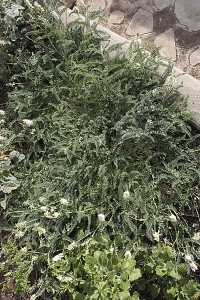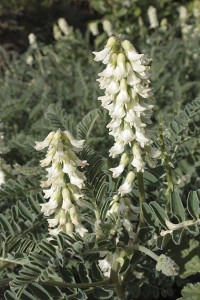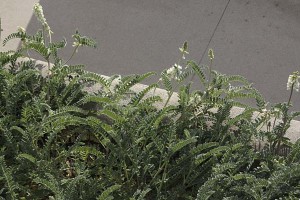Here’s a look at a new groundcover I’m trying out. The plant, Nuttall’s milkvetch (Astragalus nuttallii) is native to coastal Central California, and seems to be adapting easily to my coastal San Diego location–maybe a little too well!
Las Pilitas Nursery, who seems to be the only firm propagating the species, estimates its height to be 3-18 inches and 18 to 36 inches wide. The plant went into the ground October 12, and has topped out at a foot or so high–so far so good. But its spread, now at over six feet, has easily hit more than double the estimated maximum plant size. And that’s with no supplemental watering after the first couple of months in the ground. We’ll see if it slows down as the weather warms and the ground dries out.
The milkvetch bore some of these small, ivory-white flowers on it in October, and it’s never been without them in the intervening six months. Now that the weather is warming, the plant is getting even more interested in flowering.
As much as I enjoy its flowers, my favorite thing about this milkvetch is its delicate foliage. It’s fern-like, and so far has maintained its clean, green-to-grayish green coloration. I have the plant at front edge of the retaining wall next to the front sidewalk, so it’s easy to get face to face with the flowers and leaves. A front of the bed location would also let people enjoy this delicately textured plant.
So, if you’d like a distinctive, delicate, low, mounding groundcover for a dry spot in a zone 9 or 10 landscape, this might be just the ticket, even if the plant might get a little wide and need to be cut back.
PS: I should also mention that one of this milkvetch’s common names is “locoweed,” and the plant is supposedly poisonous. I have no idea whether it’s in the category of nightshade or no more dangerous than tomato plants. Since I have no small children around or pets that get into anything other than catnip, I’ve never let an interesting plant’s supposed toxicity stop me from growing it. But you might consider that before planting a couple acres of it.




nice! don’t quote me on this, but i think the loco part has to do with cattle using it for forage…happy to see some landscaped photos of this plant. las pilitas does great stuff, but sometimes clients have a hard time envisioning garden from the wild pictures on their website.
Hello Lostlandscape, I came over here because you corrected the ubiquitous wrong “it’s” to “its” in your comment at patientgardener’s. At last; someone who cares as much as I do.
And now I find you’re a fellow Las Pilitas fan. I think out of doors is correct on the reason for “loco”; something in it makes the cows nutty, but not necessarily humans is what I remember (but check facts before you cook up a batch!). I love our little local purple vetches, and am tempted by your Nuttall’s milkvetch photos.
Hi James, sorry for the batch of messages on Blotanical. I just added your blog to my BayAreaTendrils blogroll – it appears in a very interesting format with brackets. I guess that’s due to the name being different than the actual http? I’m sure you are far more tech-savvy than I. Every little configuration change I make tries my little grey cells. I just wanted to say again, that I look forward to your posts.
Out of doors and Pomona–
the Las Pilitas site warns about the toxicity, but I suspect it’s primarily cautionary in the way that everything else you buy these days can be covered with warning stickers.(Oops 3/3/2009: I just double-checked this note and found that the site does not talk about the plant’s toxicity, though, it does still call it a locoweed. I believe I did read it somewhere, so I’ll report back if I find out something.) There’s probably lots in all our gardens that wouldn’t be a good choice for the veggie plot…Alice–thanks for stopping by and for the link! I enjoy your posts and will be adding your blog soon the next time I go into the innards of the blog beyond posting. I have my semi-savvy moments, but other parts of things can be a little intimidating!
I am a lover of nature and somewhere I have a book on poisonous plants. I’ll get back to you on the poison factor. Of this particular plant. Another name for this plant is Nuttal’s locoweed.
Aren’t all the vetches known for this sort of enthusiasm? Like the others, I do like this foliage and flower…very enjoyable in the right spot!
Thinking of you guys today, and hope that we’ll hear some good news from your supreme court! Hang in there!
Charles,
Do let me know if your book covers this species. I can remember reading it somewhere–maybe on the tag at the nursery? I double checked with the nursery, and the stated that they’re “pretty sure it is poisonous to people and livestock.” The USDA has a page on poisonous plants that states “About half of the Astragalus species contain notrotoxins (NPA, NPOH)” which are a problem, primarily with cattle. I’d play it safe and consider this plant poisonous, but I generally don’t go around snacking on any of my garden plants…
Greg, thanks for the commiseration on our court’s deliberations. It’ll be a few months before the things are announced, but it looks like a mixed outcome at best.